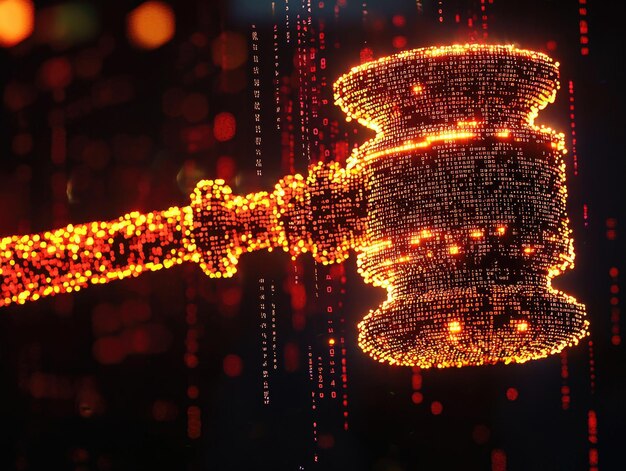US Data Privacy Law vs. Tech Giants’ Data Collection

The new US data privacy law, inspired by GDPR, is poised to significantly impact how tech giants collect and utilize personal data, mandating greater transparency and user control, which will reshape digital advertising and data monetization strategies.
The landscape of digital privacy is on the cusp of a significant transformation. As discussions around data collection and user rights intensify, a crucial question arises: Will the New US Data Privacy Law Modeled After GDPR Affect Tech Giants’ Data Collection Practices? This evolving legislative framework aims to provide consumers with greater control over their personal information, ushering in a new era of accountability for the tech industry.
Understanding the Landscape of Data Privacy in the US
For years, the United States has operated without a comprehensive federal data privacy law, leaving a patchwork of state-level regulations to govern how companies handle consumer data. This fragmented approach has often led to inconsistencies and challenges for businesses and consumers alike. The absence of a统一 framework stood in stark contrast to the European Union’s General Data Protection Regulation (GDPR), which set a global benchmark for data privacy and protection.
The increasing public awareness regarding privacy breaches and the pervasive nature of data collection by tech giants have fueled a growing demand for stronger protections. This sentiment gained significant traction following high-profile data scandals, leading to a bipartisan push for federal intervention. The current legislative efforts are largely influenced by the success and comprehensiveness of GDPR, aiming to adapt its core principles to the unique legal and economic context of the US.
The Current State of US Data Privacy Laws
While a federal law has been elusive, several states have taken the initiative to enact robust data privacy statutes. California’s Consumer Privacy Act (CCPA), and its subsequent expansion, the California Privacy Rights Act (CPRA), are perhaps the most notable examples. These laws grant consumers specific rights regarding their personal information, including the right to know what data is collected, to delete it, and to opt out of its sale.
- California Consumer Privacy Act (CCPA): Provides California residents with robust data privacy rights, including rights to access, delete, and opt-out of the sale of personal information.
- Virginia’s Consumer Data Protection Act (CDPA): Offers similar rights to consumers regarding their data, emphasizing transparency and control.
- Colorado Privacy Act (CPA): Aligns closely with CCPA and CDPA, focusing on consumer rights and data processor obligations.
These state-level initiatives have acted as proving grounds, demonstrating the feasibility and impact of such regulations within the US market. Their varying provisions, however, highlight the challenge of compliance for companies operating nationwide, strengthening the argument for a unified federal law.
Why a Federal Law Modeled After GDPR is Crucial
A federal data privacy law offers several advantages over the current state-by-state approach. It would provide a consistent legal framework across all US states, simplifying compliance for businesses and offering uniform protections for consumers. Moreover, a law inspired by GDPR would address the increasingly global nature of data flows, aligning US standards with international norms.
The primary impetus for a GDPR-like federal law is to empower individuals by giving them more control over their digital footprint. This includes rights concerning consent, access, rectification, erasure, and portability of their data. For tech giants, this means a fundamental shift from an implicit “take all data” approach to a more explicit “ask for consent and justify data use” model.
The debate around a federal data privacy law has been ongoing, with various proposals introduced in Congress. While consensus has been difficult to achieve, the growing urgency to protect consumer data and foster a more equitable digital ecosystem suggests that a significant legislative breakthrough is increasingly likely in the near future.
Key Principles of a GDPR-Modeled US Data Privacy Law
Any US data privacy law modeled after GDPR would likely incorporate several foundational principles that have defined the European regulation’s success. These principles are designed to empower individuals while holding data controllers and processors accountable for their handling of personal information. The core tenets revolve around transparency, control, and accountability, shifting the burden of responsible data management onto companies.
The aim is to create a digital environment where individuals are fully informed about how their data is used and have the power to influence those practices. This represents a significant departure from the current default, where data collection often occurs opaquely, with users having little insight or recourse.
Consent and Transparency Requirements
One of the cornerstone principles of GDPR, and one that would undoubtedly be central to a US equivalent, is the requirement for explicit consent. This means that companies would need to obtain clear, unambiguous permission from individuals before collecting, processing, or sharing their data. Generic “terms and conditions” checkboxes would no longer suffice. Consent must be freely given, specific, informed, and easily revocable.
- Granular Consent: Users should be able to consent to specific types of data processing, rather than an all-or-nothing approach.
- Clear Language: Privacy policies must be written in plain, intelligible language, avoiding complex legal jargon.
- Easy Withdrawal: Users must have the ability to withdraw their consent at any time, as easily as they gave it.
Transparency also extends to informing users about the purpose of data collection, who will have access to the data, and for how long it will be retained. This level of disclosure compels tech giants to re-evaluate their data collection practices, ensuring they are truly necessary for the services provided, rather than collected indiscriminately.
Data Minimization and Purpose Limitation
Another crucial principle is data minimization, which dictates that companies should only collect data that is necessary for the specified, legitimate purpose. This directly challenges the “collect everything, analyze later” mentality prevalent in the big data era. Tech giants would be compelled to justify each piece of data they collect, potentially leading to a significant reduction in the volume of information they store.
Purpose limitation reinforces this, meaning that data collected for one specific purpose cannot be subsequently used for an entirely different purpose without obtaining new consent. For example, data collected for a social media profile cannot be repurposed for targeted advertising campaigns without explicit user permission for that specific purpose.
This principle forces companies to be more deliberate and ethical in their data strategies, moving away from broad data collection nets towards more focused and purposeful mechanisms. It also makes auditing and compliance easier, as the purpose of data collection must be clearly defined from the outset.
Individual Rights: Access, Rectification, Erasure, and Portability
A GDPR-modeled law would grant individuals a comprehensive set of rights over their data. These rights empower consumers to understand and control their digital footprint, holding tech companies more accountable. Understanding these rights is key to grasping the full impact of such legislation on data practices.
- Right of Access: Individuals can request access to their personal data held by a company, along with information about how it’s being used.
- Right to Rectification: Users can demand corrected factual inaccuracies in their data.
- Right to Erasure (Right to be Forgotten): Under certain conditions, individuals can request the deletion of their personal data. This challenges permanent data retention models.
- Right to Data Portability: Users can obtain their data in a structured, commonly used, and machine-readable format, and have the right to transmit it to another data controller.
These rights are particularly disruptive for tech giants whose business models are predicated on extensive data collection and retention. Implementing systems to facilitate these requests efficiently will require significant investment in infrastructure and operational changes. Moreover, the “right to be forgotten” fundamentally challenges the notion of perpetual data retention, forcing companies to develop robust data lifecycle management policies.
Impact on Tech Giants’ Data Collection Practices
The potential enactment of a new US data privacy law, especially one drawing heavily from GDPR, represents a seismic shift for tech giants. Historically, these companies have thrived on vast, often unchecked, data collection, leveraging it for everything from personalized advertising to product development and market analysis. A comprehensive federal law would fundamentally alter their operational blueprints.
The shift would move from a permissive “collect all” environment to a restrictive “collect only what’s necessary with consent” model. This change is not merely cosmetic; it threatens to disrupt established revenue streams and force significant investments in compliance infrastructure and ethical data practices. The implications extend far beyond legal departments, touching product design, marketing, and engineering.

Redefining User Consent and Data Streams
Currently, many tech platforms embed data collection practices within lengthy, often unread, terms of service agreements. A GDPR-like law would dismantle this implicit consent model, necessitating explicit, opt-in mechanisms for various types of data. Users would have to actively agree to specific data uses, potentially leading to a decrease in the volume of data collected. This means companies can no longer assume consent based on platform usage.
The granular consent requirements would force tech giants to categorize and justify every data point they wish to collect. For instance, collecting location data for a navigation app is justifiable, but using that same data for targeted advertisements without explicit consent would become problematic. This could lead to a significant re-evaluation of which data streams are truly essential for core services versus those that primarily serve advertising or ancillary business functions.
Challenges to Targeted Advertising and Monetization
Much of the tech giants’ revenue, particularly for companies like Meta (Facebook) and Google, is derived from highly targeted advertising. This targeting relies heavily on extensive user data, including browsing habits, demographics, interests, and online behaviors. A strong data privacy law would directly challenge this model, as obtaining explicit consent for every piece of data used in advertising would be cumbersome, if not impossible.
The ability to profile users extensively would be curtailed, forcing advertisers to rely on less precise, or contextual, targeting. This could lead to a reduction in advertising effectiveness and, consequently, lower ad revenues for platforms. Companies might have to explore alternative monetization strategies that are less data-intensive, such as subscription models or more generalized advertising.
Furthermore, the “right to opt-out of sale” would become more prominent, allowing users to prevent their data from being shared with third-party advertisers or data brokers. This directly impacts the data brokerage industry and the broader ecosystem of data-driven marketing, requiring tech companies to build robust systems for managing opt-out preferences across their vast networks.
Increased Compliance Costs and Legal Risks
Adhering to a comprehensive new data privacy law would entail substantial investments for tech giants. This includes upgrading privacy infrastructure, developing new consent management platforms, training employees, and hiring dedicated privacy officers and legal teams. The complexity of managing user rights requests, such as access, deletion, and portability, across billions of users would be immense.
Beyond operational costs, the legal risks associated with non-compliance would be severe. GDPR imposes hefty fines, up to 4% of a company’s annual global turnover, for serious breaches. A similar penalty structure in the US could equate to billions of dollars in fines for major tech companies. This financial incentive would push companies to prioritize compliance, not just as a legal obligation, but as a critical business imperative.
The potential for class-action lawsuits and reputational damage from data breaches or privacy violations would also increase. Companies would need to demonstrate robust data governance frameworks and transparent data handling practices to mitigate these risks. This could also lead to a more conservative approach to new product development, with privacy by design becoming a non-negotiable feature rather than an afterthought.
Addressing Consumer Control and Empowerment
The primary objective of a GDPR-modeled US data privacy law is to shift power dynamics, putting consumers firmly in control of their digital identities. This involves more than just setting rules; it’s about empowering individuals with actionable rights and sufficient information to make informed decisions about their personal data. The success of such legislation hinges on its ability to translate legal provisions into tangible, user-friendly mechanisms for control.
This means moving beyond abstract legal concepts to practical applications where users can easily understand, manage, and exercise their data rights. It necessitates a proactive role from tech companies in facilitating these controls, rather than simply reacting to legal obligations.
Simplified Privacy Settings and Dashboards
A significant challenge in current tech ecosystems is the complexity of privacy settings. Often buried deep within menus and presented with confusing terminology, these settings are rarely optimized for user accessibility. A new law would likely mandate simplified, user-friendly privacy dashboards where individuals can easily review their data, adjust preferences, and exercise their rights.
This could include features such as:
- Centralized Privacy Hubs: A single, easy-to-find location for all privacy settings and data management tools.
- Readability: Eliminating jargon and presenting choices in clear, concise language.
- Granular Controls: Allowing users to select exactly what data they share and for what purposes, beyond simple on/off switches.
Tech giants would need to invest heavily in user interface (UI) and user experience (UX) design to make these controls intuitive and accessible to a broad audience, not just tech-savvy individuals. This shift would reflect a genuine commitment to empowering users, rather than merely meeting minimum legal requirements.
Enhancing Data Security and Breach Notification
While data privacy focuses on how data is collected and used, data security is about protecting that data from unauthorized access, loss, or disclosure. A comprehensive privacy law would undoubtedly strengthen requirements for data security, mandating robust safeguards and encryption protocols to protect sensitive consumer information.
Furthermore, prompt and transparent data breach notification would be a critical component. Companies would be legally obliged to inform affected individuals and relevant authorities quickly following a data breach, detailing the nature of the breach, the data involved, and the steps being taken to mitigate harm. This ensures accountability and allows individuals to take protective measures if their data has been compromised.
The emphasis on both privacy and security ensures a holistic approach to data protection, recognizing that control over data is meaningless if that data is not adequately secured. This dual focus places significant responsibility on tech giants to maintain the highest standards of cybersecurity.
The combination of these measures would create a more trustworthy digital environment, fostering greater confidence among consumers. When individuals feel their data is secure and their privacy preferences are respected, they are more likely to engage with online services, albeit under new, more protective terms.
Potential Economic and Societal Ramifications
The implementation of a comprehensive US data privacy law, particularly one mirroring GDPR’s stringent requirements, carries profound economic and societal implications that extend beyond the immediate operations of tech giants. While the primary goal is enhanced consumer protection, the ripple effects could reshape entire industries, influence innovation, and even alter the competitive landscape.
The shift from a data-hungry ecosystem to one emphasizing data minimization and consent is not without its intricate challenges and potential benefits. It prompts a re-evaluation of established business models and forces a reconsideration of the role of data in the digital economy.
Impact on Smaller Businesses and Startups
While tech giants possess the resources to adapt to new regulations, smaller businesses and startups might face disproportionate challenges. Compliance costs, including legal fees, technology upgrades, and staff training, could be a significant barrier to entry or growth for companies with limited budgets. This raises concerns about potential market consolidation, where smaller players might struggle to compete under the new regulatory burden.
However, the law could also level the playing field by curbing the data advantage of large corporations. Smaller businesses that prioritize consumer privacy from the outset might gain a competitive edge, fostering trust and differentiation in the market. Regulators would need to consider creating tiered compliance frameworks or providing resources to assist smaller enterprises in navigating the new legal landscape, ensuring that innovation is not stifled.
The emphasis on “privacy by design” could also drive a new wave of innovation, as companies develop privacy-centric products and services. This could open doors for new startups specializing in privacy-enhancing technologies or compliance solutions.
Innovation and the Future of Data-Driven Technologies
Critics of stringent data privacy laws often argue that they stifle innovation by restricting access to the data that fuels artificial intelligence, machine learning, and other data-intensive technologies. While some adjustments will undoubtedly be necessary, the long-term impact on innovation is more nuanced. Instead of stifling it, such laws often push innovation in new, more ethical directions.
Companies might move towards privacy-preserving AI techniques, such as federated learning (where models are trained on decentralized data without ever seeing the raw data) or differential privacy (adding noise to data to protect individual identities). This shift could lead to more robust and ethical AI systems, built on principles of trust and transparency rather than sheer volume of data.
The focus could also shift from extensive data collection to contextual data use, prompting companies to become more creative in how they derive value from limited, consent-based data sets. This could foster a new generation of privacy-centric products and services that demonstrate that innovation and user privacy are not mutually exclusive but can, in fact, be complementary.
Shifting Public Trust and Data Responsibility
Perhaps the most significant societal ramification is the potential for a fundamental shift in public trust regarding data handling. Consistent and enforceable data privacy laws can rebuild consumer confidence in digital services, which has been eroded by years of data breaches and intrusive practices. When people feel their data is respected and protected, they are more likely to engage with the digital economy without constant apprehension.
The law also fosters a culture of data responsibility within organizations. It externalizes the cost of data misuse, making it a tangible financial and reputational liability. This encourages companies to embed privacy considerations into their product development cycles and corporate governance from the ground up, moving privacy from a “checkbox compliance” exercise to a core business value.
Ultimately, a strong US data privacy law modeled after GDPR aims to create a more equitable digital ecosystem where individuals have agency over their information, and businesses operate with greater transparency and accountability. The transition will be challenging, but the potential long-term benefits of enhanced trust and ethical innovation could reshape the digital landscape for the better.
Enforcement and Future Outlook
The effectiveness of any data privacy law hinges heavily on its enforcement mechanisms. A well-crafted law without robust enforcement can become a mere suggestion. For a GDPR-modeled US federal privacy law, identifying the enforcing bodies, outlining their powers, and anticipating the types of penalties will be crucial determinants of its ultimate impact on tech giants’ data practices. The future outlook remains dynamic, subject to legislative intricacies and technological advancements.
Effective enforcement requires sufficient resources, expertise, and a clear mandate to investigate and penalize non-compliance. Without these elements, even the most stringent regulations might fail to achieve their intended purpose of reining in unchecked data collection.

Federal Agencies and Enforcement Powers
In the US, several federal agencies could potentially share responsibilities for enforcing a new data privacy law. The Federal Trade Commission (FTC) is often cited as the most likely primary enforcer due to its existing mandate over consumer protection and unfair trade practices. The FTC already has experience with data privacy enforcement, albeit under a limited statutory framework.
Other agencies, such as the Department of Justice (DOJ) or even a newly created independent data protection authority (similar to European models), could also play a role. The scope of their powers would be critical, including the ability to:
- Investigate Complaints: Proactively or reactively investigate alleged violations.
- Impose Fines: Levy significant financial penalties for non-compliance, potentially scaled by revenue.
- Mandate Remedial Actions: Order companies to change their data practices, implement new security measures, or delete illegally collected data.
- Issue Guidance: Provide clear guidelines for businesses on how to comply with the law.
The allocation of enforcement powers and the level of resources provided to these agencies will directly influence the speed and effectiveness with which a new law can bring about change in the data practices of tech giants. A fragmented enforcement landscape, or one with limited funding, could undermine the law’s intent.
The Path to Federal Legislation
The journey to a comprehensive federal data privacy law in the US has been a protracted one, marked by differing views among lawmakers, industry stakeholders, and privacy advocates. Key sticking points often include the scope of preemption over state laws (whether a federal law would supersede existing state-level regulations), the definition of personal data, and the establishment of a private right of action (allowing individuals to sue companies directly for privacy violations).
Despite these challenges, the bipartisan recognition of the need for federal action is growing. High-profile data breaches, increasing public concern, and the success of state-level laws like CCPA provide momentum. Negotiations would likely focus on finding a balance that protects consumer rights without unduly burdening businesses, particularly smaller ones.
The legislative process is often slow, but the confluence of factors – public demand, international alignment, and the shortcomings of the current fragmented system – suggests that a breakthrough is more probable than ever. Such a law would represent a landmark achievement in consumer protection for the digital age.
Anticipating the Next Decade in Data Privacy
Even with a new federal law, the evolution of data privacy will not cease. Technological advancements, such as further developments in artificial intelligence, virtual reality, and the Internet of Things (IoT), will continually present new challenges and questions regarding data collection and usage. A dynamic legal framework will be necessary to adapt to these changes.
The next decade will likely see increased focus on:
- Ethical AI: Regulations addressing bias in AI algorithms and the data used to train them.
- Biometric Data: Specific protections for highly sensitive biometric information.
- Cross-Border Data Transfers: International agreements and frameworks for global data flows.
Tech giants will need to maintain agility and foresight, not just to comply with current laws, but to anticipate future regulatory trends. Privacy will transform from a regulatory obligation into a competitive differentiator, as consumers increasingly choose services from companies that demonstrate genuine respect for their personal data. The future of data privacy in the US is poised for significant, continuous transformation.
| Key Point | Brief Description |
|---|---|
| 🛡️ Data Control | New law aims to give consumers more control over their personal data. |
| 🔄 Tech Giants’ Shift | Requires fundamental changes to how tech companies collect, process, and monetize data. |
| 💸 Compliance Costs | Significant investments in infrastructure and legal teams for compliance expected. |
| 📈 Future Innovation | May shift innovation towards privacy-preserving technologies and ethical data use. |
Frequently Asked Questions
▼
A GDPR-modeled US data privacy law refers to proposed federal legislation that would adopt core principles from the European Union’s General Data Protection Regulation. This includes stricter rules on consent, enhanced individual rights over personal data, and increased accountability for companies handling consumer information, aiming to create a comprehensive, uniform privacy framework across the United States beyond current state-specific laws.
▼
The law will necessitate significant changes, moving from implicit to explicit user consent for data collection. Tech giants will likely face restrictions on broad data harvesting, requiring them to justify data relevance and provide granular user controls. This could reduce the volume of data collected, impact targeted advertising models, and increase compliance costs for large technology companies, forcing a re-evaluation of current data monetization strategies.
▼
Consumers could gain significant rights, including the right to access their personal data, rectify inaccuracies, and request data deletion (the “right to be forgotten”). The law may also include data portability, allowing users to move their data between services, and the right to opt-out of data sales to third parties. These rights empower individuals to have greater control and transparency over their digital footprint.
▼
Yes, such a law is highly likely to impact targeted advertising revenue. Relying on explicit consent for data used in personalized ads could decrease the precision and scale of targeting. Tech companies may need to innovate with less data-intensive advertising models or focus more on contextual advertising. This shift implies a potential decrease in ad effectiveness, leading to a re-evaluation of ad pricing and overall digital advertising strategies.
▼
Smaller businesses could face significant challenges due to compliance costs, including legal fees, technology upgrades, and staffing for privacy operations. While the law aims for broad protection, meeting new consent requirements and managing data subject requests can strain limited resources. Regulators may consider tiered compliance or provide support to ensure that the law doesn’t inadvertently stifle innovation or disproportionately burden small and medium enterprises.
Conclusion
The prospect of a new US data privacy law, heavily modeled after GDPR, marks an undeniable turning point for tech giants and the broader digital economy. It signifies a profound rebalancing of power, shifting the stewardship of personal data back into the hands of consumers. While the legislative path has been complex and deliberate, the growing imperative for stronger data protection, fueled by public demand and international precedents, suggests that such a law is not merely a hypothetical possibility but an increasingly likely development. The inevitable disruption to established data collection practices, monetization strategies, and operational frameworks will compel tech companies to innovate, prioritize ethical data handling, and rebuild trust with their user base. The future digital landscape, shaped by these robust privacy principles, promises a more accountable, transparent, and user-centric experience for everyone.





